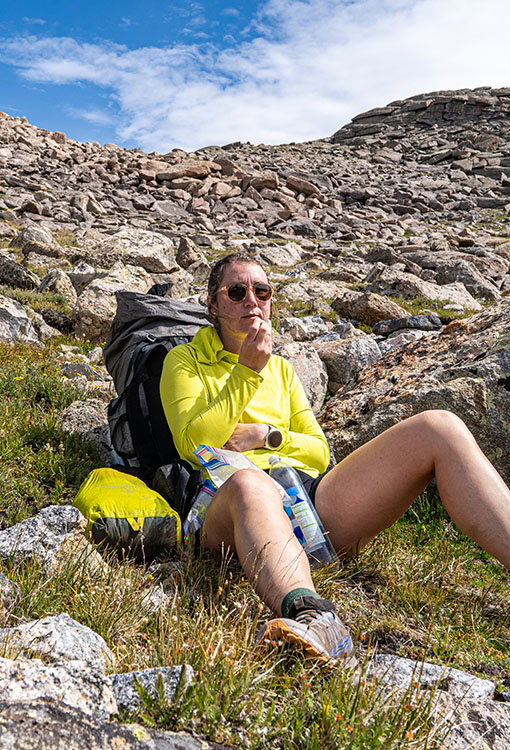
SOMETIMES JUST BEING COOL IS EFFICIENT ENOUGH
Efficiency on Trail: Maximizing your time to go farther
Hiking is a deeply personal experience, shaped by individual style and preference. There’s no single “right” way to do it, and you don’t need to follow every tip here to prove anything. Some of you might even laugh at the idea— you’re already crushing 35-mile days without a second thought, maybe you don’t even brush your teeth until the first water source of the day. And that’s okay.
Lets take a look at a hiker whose trail name is “Case Study” and is currently hiking 20 miles per day but would like it to look more like 25. Case Study is hiking the PCT and we know they’re up by 6am and on trail by 7am which isn’t too terrible, but, they’re currently setting up camp at 5:30 and it doesn’t get dark until 8:30! They’re wasting daylight and losing out on those sweet precious miles that they could be utilizing their time towards.
TIME IN CAMP
Let’s assume Case Study typically hikes two miles an hour. First things first, they’re now utilizing their daylight and getting into camp at 8 instead of 5:30, giving them plenty of time to set up and eat before it gets dark. With just those 2.5 hours going towards hiking, we’ve already increased their daily mileage by 5 miles. Now let’s have them get up at 5:30 and improve their out of camp efficiency by 30 minutes. They’re now on trail by 6am and have added an additional 2 miles to their day! We’re talking about seven extra miles per day, turning that 20-mile day into 27 miles just by hiking longer. This is pretty obvious that hiking more would net more miles, but it’s just one example that many hikers overlook when they’re stuck in a routine. Hiking just one extra hour per day would net you 300 extra miles over a 150-day thru-hike (assuming you took no zeros). If we look at it as a 25 mile a day average, you’re saving yourself 12 days on the total time it could take you to finish the thru hike. That would also save you $396 – $792 assuming you’re spending a total of $5,000 to $10,000 dollars for your thru-hike. Check out our Thru-hiker Finances article for a more detailed breakdown.
We mentioned Case Study improving their out of camp efficiency so let’s take a look at what that actually means.
PREPPING ITEMS IN CAMP
Instead of taking the time to do morning routines like cooking breakfast, filtering water, loading your snacks for the day, etc., do it the night before. (Only where appropriate, don’t load your food in your backpack the night before in a bear area or we will call your mom to come pick you up.)
For example:
If you like having coffee in the morning, your morning routine might include filtering a liter of water, heating up the water, mixing in instant coffee, stirring, and letting it settle before drinking it. That’s a more involved task than you might expect and is costing you time. So how can we possibly make morning coffee more efficient and get on trail faster? A few things:
- Drinking your coffee cold automatically cuts the time it takes to pull out the stove and heat your water up.
- Filtering and mixing your coffee up the night before while already in camp will save you those tasks in the morning.
- Drinking your coffee while you hike will get you out of camp sooner and prevent that lazy camp lingering that tends to happen on a foggy morning.
Estimated time saved: 15 minutes
We all know it’s not just coffee that’s a part of the morning routine. A cooked breakfast on top of hot coffee is a double whammy where time wasted is concerned. There are several levels to this so to keep it easy we’ll show the hierarchy of breakfast efficiency.
- The biggest time waster is the cooked breakfast. We’ll use oatmeal for our example.
- If you switch from cooking your breakfast to cold soaking you can save a little bit of time here but you still have to wait for the food to rehydrate, so doing it the night before is recommended so it’s ready to eat when you wake up.
- Switching from a breakfast that requires a tool to eat like a spoon, to bars that require no tools nor prep time is going to be the most efficient way to go about your morning meal. We don’t recommend skipping breakfast. Eating your first bar of the day as soon as you start walking is a sure fired way to get you moving and fueled.In case you’ve never realized it, you can eat while you walk. And stopping to eat takes time. The real big miles are made when all of your food is a pocket snack, and you can eat on the go. Imagine a world where you don’t have to stop for breakfast, lunch, or dinner!
Estimated time saved: 15 minutes for breakfast, extrapolate to however many cooked meals or stops you had previously.
A real pro move for efficiency in camp? Pre-dig a cathole before you go to bed to take the guesswork out of your morning meeting. We’ll explain how your shelter system can impact your time in camp later on in this article as well.
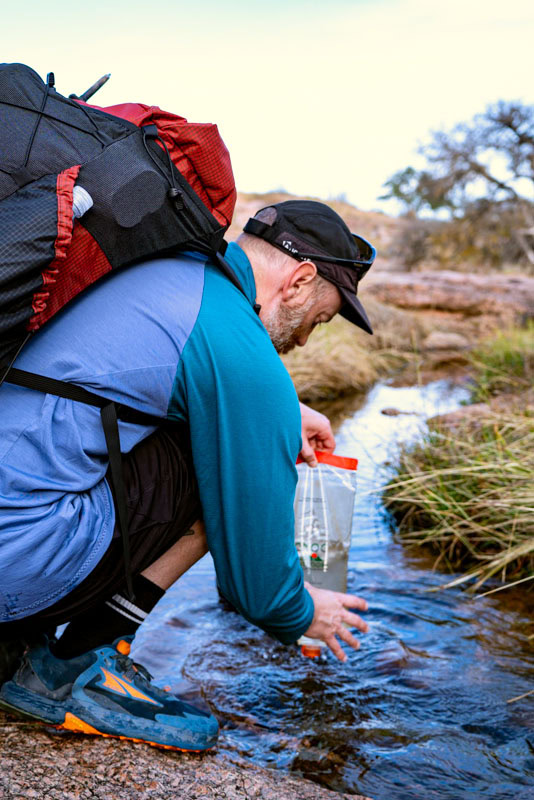
FILTERING AT CAMP IN THE EVENING WILL SAVE YOU IN THE MORNING
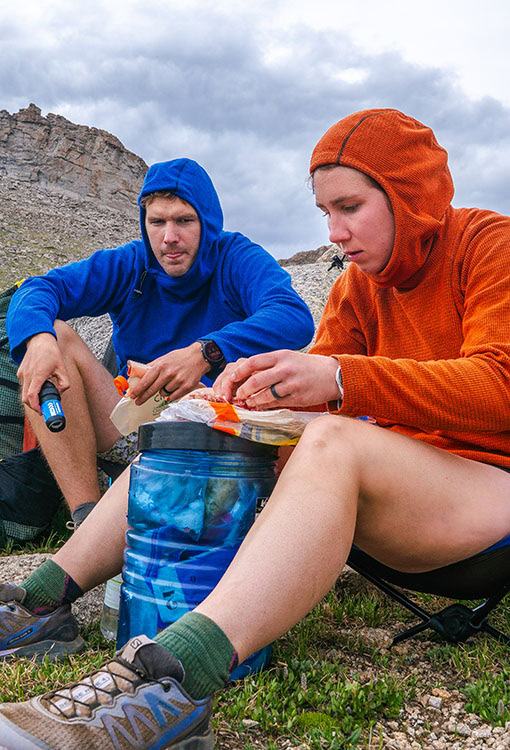
THE TYPES OF FOOD YOU CHOOSE CAN IMPACT YOUR TIME ON TRAIL
WATER AND BREAKS
So, how else can we reclaim time on the trail to cover more miles without lingering too long in camp? One key strategy is making breaks more efficient. Timing your mid-morning, lunch, or afternoon snack stops around water sources that you plan to visit allows you to rest while filtering, maximizing downtime. This approach also reduces unnecessary stops, especially if you tend to take breaks whenever hunger strikes, regardless of water availability. By being more intentional with your breaks, you can keep a steady pace without sacrificing comfort or hydration.
For lunch, consider cold soaking your meal instead of cooking to save time. Stopping at a water source about an hour before your planned lunch break to start the soak, so your food is ready to eat when you stop.
When it comes to filtering water, keeping your filter clean and flowing efficiently is crucial. A clogged filter with a slow flow can be a major time drain. Take advantage of any opportunity to backflush and maintain it to ensure steady performance.
Some hikers carry two Smartwater bottles—one for dirty water and one for clean. With this setup, you can only filter one liter at a time before refilling and filtering again. In contrast, using a two-liter bag allows for a single fill in both bottles and you only have to put the filter on one time, making the process more efficient—especially on trails with long water carries. However, when water is plentiful, drinking straight from a filter attached to a bottle is the fastest way to rehydrate and get moving again. This harkens back to style and preferences in your hiking hobby.
RESUPPLY/TOWN CHORES
Sending yourself resupply boxes is a great way to streamline town stops, especially if you can have them delivered to post offices or businesses within walking distance of the trail—eliminating the need for a shuttle or hitch. This efficiency can turn a Zero Day (no trail miles) into a Nero (a shorter hiking day with a night in town), or even better, a Hero Day—where you get into town, take care of your resupply and chores, and get back on trail the same day. This not only helps you cover more miles but also saves money by reducing the need for a hotel stay. On the other hand if you incorrectly time your package with your arrival you could see yourself having to spend more time in town waiting for the post office to open or for the package to arrive.
Having fewer devices to charge—like just a battery bank and phone instead of additional gear like a Kindle, camera, and spare batteries—can save time during town stops. As with most things, battery bank choices come down to personal preference, but there are two main approaches. One strategy is using a smaller battery bank, which charges quickly and gets you back on trail sooner. The other is opting for a larger battery bank that can last multiple resupply stops, reducing the need for frequent town visits altogether. Each approach has its trade-offs, so it’s about finding what works best for your hiking style.
Time in town is the great equalizer. As disciplined as you think you might be, the temptations and amenities of town will make you reconsider what’s most important in life.
TYPES OF FOOD (COLD, COOKED, DRY)
We gave some examples of how your food can impact your time on trail earlier but now let’s take a closer look at the different types of food and how they impact efficiency.
When it comes to food efficiency, there’s a general hierarchy, with cooked meals being the most time- and energy-consuming option as we showed with our oatmeal breakfast. Cooking requires more than just the food itself—you need fuel, a lighter, a stove, water, time, and patience for the water to boil. Beyond just cooking, the process also requires stopping, setting up, and cleaning up, all of which eat into your hiking time.
Cold soaked food is less time-consuming and more energy efficient in that it requires no fuel, stove, or lighter to make it happen. Just some water and good old fashioned patience.
Dry food like bars or jerky is the most time and energy-efficient in that you do not need any additional resource or tool to get those calories in. They can be eaten on the go and don’t need a lot of maintenance to keep you fueled up throughout the day. Plus there’s no clean up.
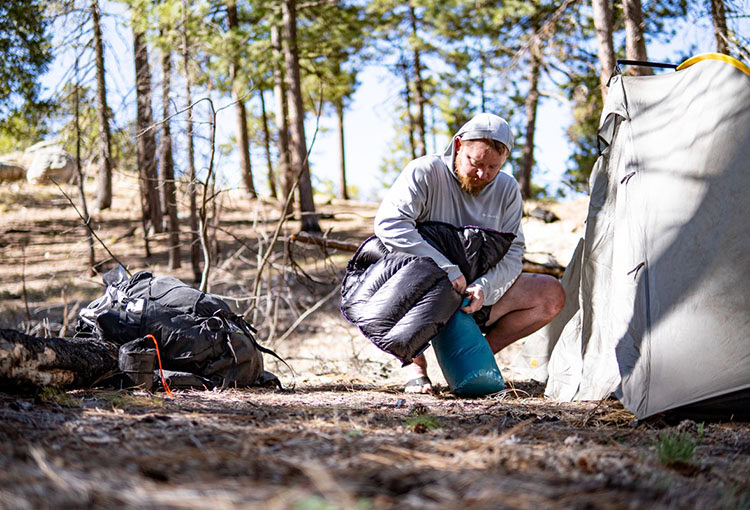
IF YOU WANT TO BE EFFICIENT, DON’T BRING STUFF SACKS LIKE JEREMY!
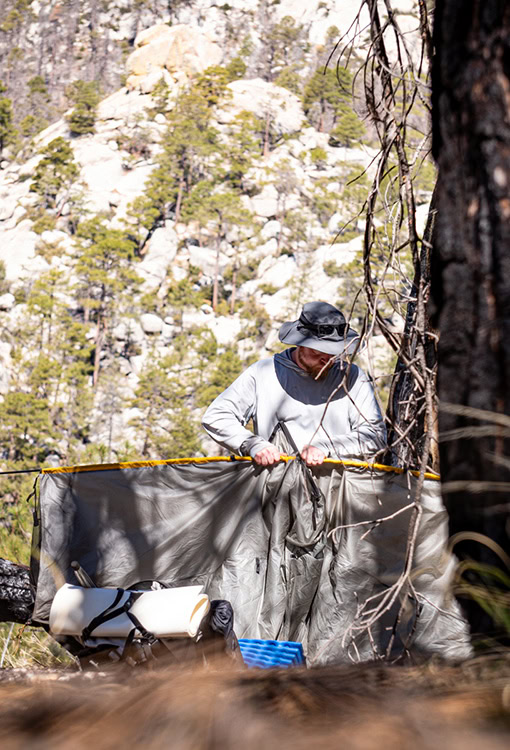
JEREMY SHOWS THE STRUGGLES OF A FREE STANDING TENT
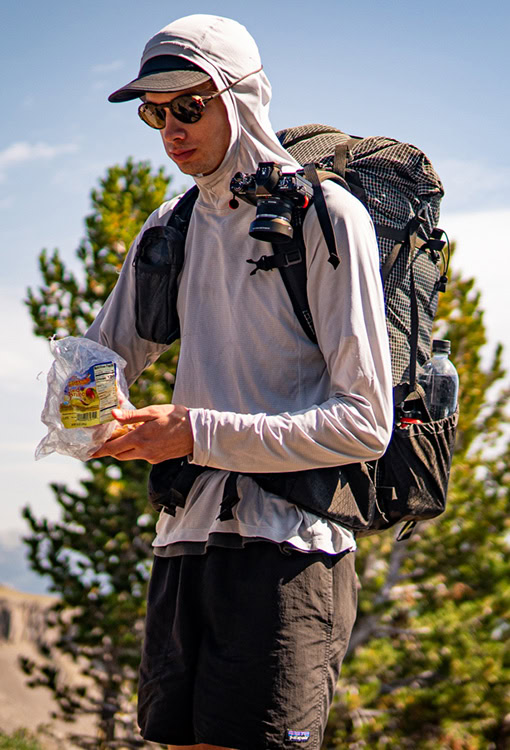
OWEN IS EATING WHILE HIKING, NOW THAT’S EFFICIENT!
SHELTER SYSTEMS: TENT VS TARP VS COWBOY CAMPING
One advantage of a trekking pole shelter or tarp over a free-standing tent is the simplicity of packing up. A tarp and bivy can be quickly stuffed into your pack, getting you on the trail faster. In contrast, a free-standing tent involves multiple components—a bug net, poles that need to be disassembled, a rain fly, and sometimes a groundsheet. That’s a lot of extra gear to manage!
Trekking pole shelters are often single-walled, meaning the entire structure is one sewn-together piece. Others have two separate components—a rain fly and a bug net—offering a setup similar to a tarp and bivy but with more space and protection.
Single-wall shelters are the quickest to set up and take down since you’re only dealing with one piece, while double-wall shelters provide better ventilation and flexibility, especially in wet conditions. The ability to pitch just the rain fly during a sudden afternoon thunderstorm can be a game-changer, keeping you dry without needing to set up the entire system.
Another way to save time is cowboy camping—skipping the tent altogether. If bugs are minimal and the forecast is clear, sleeping under the open sky can simplify your camp routine. With no tent, rain fly, or bug net to deal with, setting up at night is effortless, and packing up in the morning is even easier—a win-win for efficiency.
WALKING
Most hikers covering big miles aren’t necessarily moving at a blazing pace—they’re just walking for long hours at a steady, comfortable speed. If you try to squeeze in more miles by pushing your pace too hard within the same timeframe, you’ll likely burn out faster, lose motivation, and slow down as the day goes on. You might also wake up feeling even sorer the next morning. Finding and maintaining a comfortable walking rhythm makes it much easier to sustain long days on the trail.
- Take shorter steps with a higher cadence – This helps reduce the impact on your knees and ankles, preventing strain from heavy, uncontrolled steps. A smoother, more intentional stride can make a big difference over long distances.
- Avoid stepping on or kicking rocks and roots – It may seem obvious, but many hikers don’t realize how much these small missteps can wear down their feet and ankles. The jarring impact of kicking a rock or the sharp pressure of stepping on a single point can add up over time, increasing discomfort and even leading to injuries that could force you off-trail or slow you down significantly.
- Maintain a breathing rhythm – Walk at a pace that allows you to breathe in through your nose and out through your mouth. This helps regulate your heart rate and keeps your breathing steady. If you find yourself constantly gasping through your mouth, it might be a sign to ease up and settle into a more sustainable pace. If you’re having trouble while going uphill, be sure to take smaller, shorter steps that enable you to keep momentum.
There are countless ways to build out your kit and many different approaches to finding what inspires you to get outside. With social media constantly showcasing the latest trends in hiking, it’s easy to feel pressured to follow certain practices or buy gear to solve problems you may not even have. But hiking is a lifelong journey, and your setup will likely evolve over time. Don’t be afraid to experiment and discover what works best for you. By applying some of these efficiency principles, you might accomplish more than you ever thought possible.
CONCLUSION
When you’re trying to maximize your effectiveness and efficiency out on trail that usually means sacrificing some sort of comfort in pursuit of something greater. This can come in the form of gear, food, and even the amount of breaks you take. Ensuring you’ve got your routine and its effectiveness maximized can save you real time and money while out on a thru-hike where exposure to late season weather and burning through your savings are a real concern.


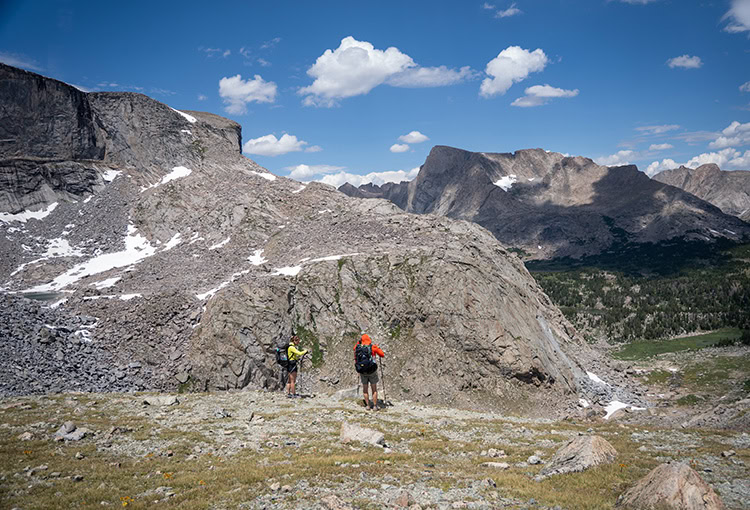
0 Comments